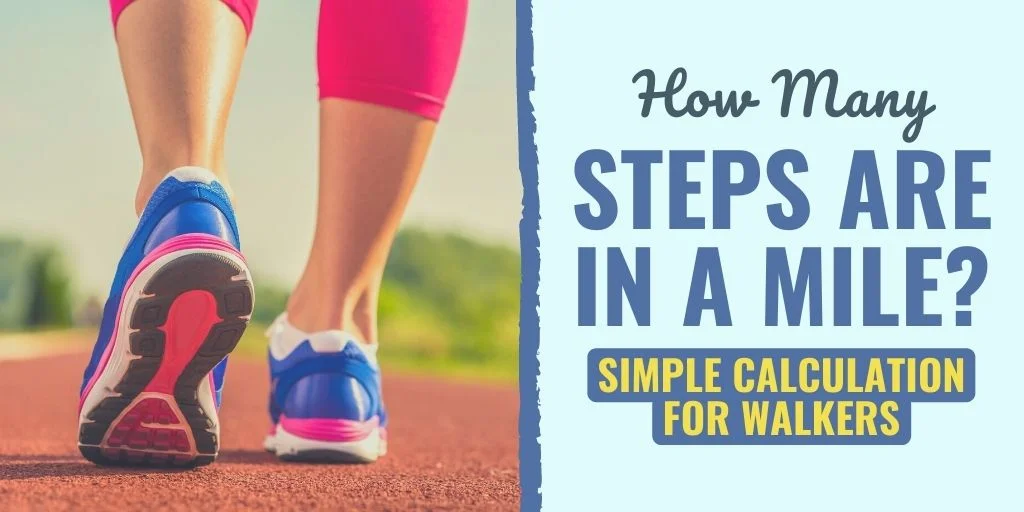How Many Steps In a Mile
Introduction
How Many Steps in a Mile
Generally speaking, a mile has around 2,000 steps.
Pace can affect your steps-per-mile marginally, but not as much as it would appear because your stride won’t alter much depending on how quickly or whether you’re running.
How Many Steps Are in a Mile? Here’s How to Calculate Your Steps
- To get the most out of your exercise regimen, it’s critical to figure it out.
- If you’re a ritualistic step counter, you’ve undoubtedly calculated the mileage you’ll accrue by reaching your 10,000 daily step target.
- Ultimately, you may believe that a mile of walking is a lot, only to discover that it really just equates to a few thousand steps.
- Alternatively, you may have seen that the 10,000 steps you do each day don’t precisely correspond to your friend’s or partner’s mileage.
- Warning: there will be variation in the amount of steps in a mile among individuals.
- When walking or jogging, the number of steps it takes for each of us to cover a mile depends on both pace and stride length.
- Nevertheless, we can estimate the number of steps in a mile, and being aware of this fact might improve your general welfare and motivate you to walk more.
- Anything cannot be controlled if it cannot be measured.
- This is especially important when it comes to how fitness trackers help you remember to take your daily steps.
- The capacity to proactively chart your path to health achievement and place the power of ownership and responsibility squarely in your hands are the most significant features of fitness trackers.
- You may use the power and potential of fitness trackers to boost your daily activity and step counts by configuring them to offer you hourly reminders for step counts, celebrating milestones, or even light prods to get you moving!
How many steps are in a mile
- Generally speaking, a mile has around 2,000 steps.
- It has been shown that the typical stride length is between 2.1 and 2.5 feet, meaning that most people need to take around 2,000 steps to cover a mile.
- Pace can affect your steps-per-mile marginally, but not as much as it would appear because your stride won’t alter much depending on how quickly or whether you’re running.
- It’s not as much of a difference as one might think a mile of moderate walking equals around 2,000 steps, while a mile of easy running may come out to be slightly closer to 1.2 miles per 2,000 steps.
How to calculate your steps
- Measure the length of one stride if you’re truly interested in finding out how many steps are in your personal mile.
- Some fitness monitoring apps, like Apple Health, can calculate your average stride length based on walking data.
- Divide the distance covered by your stride length by the 5,280 feet that make up a mile.
- There is no “perfect” stride length; instead, each of us has a different one depending on a variety of circumstances.
- The most crucial thing is to move your body consistently, although you might be able to shorten your stride if you view taking fewer steps every mile as a badge of honor.
- Height, flexibility, and joint range of motion are the three most important stride elements.
- Although you cannot alter your height, you may influence your range of motion and flexibility with stretching and exercise routines, says Savage.
- The greatest approach to enhance your flexibility in this area is to conduct dynamic (mild movements) and static (stationary) stretches. Flexibility across your posterior chain, including your hamstrings, calves, and glutes, dramatically affects stride length.
- Targeted mobility exercises that aim to expand the range of motion in the hip, knee, and ankle joints are a good way to improve joint range of motion, which is equally significant in those regions.
Why it matters to know how many steps there are in a mile
- Understanding the total distance you walk on a daily basis (apart from your scheduled exercise) will help you better understand your goals and degree of physical activity.
- In daily life, walking is an underappreciated type of exercise or active rehabilitation.
- We know that cardiovascular strength training improves running performance, but walking is also incredibly beneficial to the heart and lungs, according to CPT, an F45 Training Recovery Athlete.
- In addition, walking strengthens bones, elevates mood, sharpens cognitive abilities, lowers blood pressure, and even aids with sleep.
- In addition, taking a stroll in the outdoors provides you with fresh air and vitamin D!
- Not only is walking a healthy “bonus exercise” when daily step objectives are met, but it also works well as an adjunct to strength and cardio training programs.
- Walking’s steady advantages are combined with an intense workout to create a well-rounded fitness regimen.
- Walking’s steady, restorative pace makes it the ideal partner for energetic activities.
- And lastly, setting and achieving new daily step targets might even help you feel more confident.
- It gives you a chance to recognize and appreciate your accomplishments every day!
How many steps should you take daily?
- The majority of individuals take between 3,000 and 4,000 steps a day, but the Centers for Disease Control and Prevention advise adults to double that amount (and then some), which is where the 10,000 figure comes from.
- However, there are even more advantages if you reach 10,000 steps a day.
- According to recent studies, doing as few as 4,000 steps a day may lower your chance of dying from any cause.
How to get more out of walking
You may maximize the benefits of walking your daily steps by using these simple, expert-backed tips:
Increase your walking pace. This increases heart rate and positive stress on the heart, which enhances heart health and endurance.
Change the tempos throughout your walking routine(thus switching between slower and quicker speeds) to increase physical stamina and strength; this also activates brain regions that keep your muscles guessing.
Cover different terrain—walking over uneven terrain promotes greater mobility and range of motion.
Add some weight either by carrying light dumbbells or wearing a weighted vest. The body becomes more resilient when we exercise, and lifting weights and engaging in aerobic activities are important ways to increase bone density and build stronger bones as we age. Walking with weight demands more energy for improved cardiovascular strength and a larger calorie burn, but it may also give increased intensity while maintaining a low-impact workout.
Walking and Running
- An earlier study showed the following average steps per mile at walking and running speeds as a fast guide:
- 2,252 steps are taken each mile while walking 20 minutes per mile (3 miles per hour).
- 1,935 steps are taken each mile walking 15 minutes per mile (4 miles per hour).
- 1,951 steps per mile at a pace of 12 minutes per mile, or 5 miles per hour.
- 1,672 steps per mile at a pace of 10 minutes per mile, or 6 miles per hour.
- 1,400 steps per mile at a pace of 8 minutes per mile, or 7.5 miles per hour.
- This is the maximum distance you might get with different step totals using these averages. Remember that this will change based on how long your steps are.
| Steps | Walk (With a Shorter Step) | Jog or Walk Quickly (Moderate Stride) | Run (Long Stride) | Quick Run (Extended Stride) |
| 1,000 | 0.4 miles | 0.5 miles | 0.6 miles | 0.7 miles |
| 2,000 | 0.9 | 1.0 | 1.2 | 1.4 |
| 3,000 | 1.3 | 1.5 | 1.8 | 2.1 |
| 4,000 | 1.8 | 2.1 | 2.4 | 2.9 |
| 5,000 | 2.2 | 2.6 | 2.9 | 3.6 |
| 6,000 | 2.7 | 3.1 | 3.5 | 4.3 |
| 7,000 | 3.1 | 3.6 | 4.1 | 5.0 |
| 8,000 | 3.6 | 4.1 | 4.7 | 5.7 |
| 9,000 | 4.0 | 4.6 | 5.3 | 6.4 |
| 10,000 | 4.4 | 5.1 | 5.9 | 7.1 |
| 12,000 | 5.3 | 6.2 | 7.1 | 8.6 |
| 15,000 | 6.7 | 7.7 | 8.8 | 10.7 |
| 20,000 | 8.9 | 10.3 | 11.8 | 14.3 |
| 25,000 | 11.1 | 12.8 | 14.7 | 17.9 |
| 30,000 | 13.3 | 15.4 | 17.0 | 21.4 |
| 40,000 | 17.8 | 20.5 | 23.5 | 28.6 |
Estimations by Height
- Many fitness trackers ask for your height during setup and base their calculations on estimates of your height.
- The following are approximate steps per mile based on a stride-to-height ratio:
| Height | Steps per Mile |
| 4 feet 10 inches | 2,601 steps |
| 4 feet 11 inches | 2,557 steps |
| 5 feet even | 2,514 steps |
| 5 feet 1 inch | 2,473 steps |
| 5 feet 2 inches | 2,433 steps |
| 5 feet 3 inches | 2,395 steps |
| 5 feet 4 inches | 2,357 steps |
| 5 feet 5 inches | 2,321 steps |
| 5 feet 6 inches | 2,286 steps |
| 5 feet 7 inches | 2,252 steps |
| 5 feet 8 inches | 2,218 steps |
| 5 feet 9 inches | 2,186 steps |
| 5 feet 10 inches | 2,155 steps |
| 5 feet 11 inches | 2,125 steps |
| 6 feet even | 2,095 steps |
| 6 feet 1 inch | 2,067 steps |
| 6 feet 2 inches | 2,039 steps |
| 6 feet 3 inches | 2,011 steps |
| 6 feet 4 inches | 1,985 steps |
Benefits of Daily Walking
- Regular walking has various advantages that go beyond physical health.
- Benefits of walking can include:
- Maintaining (or achieving) a healthy weight
- Reduced food cravings
- Better sleep
- Stronger bones and muscles
- Decreased stress
- Increased resistance to disease
- Decreased chance of developing some diseases, such as cancer, diabetes, or heart disease
- Decreased joint pain
- Improved recall
- Decreased chance of getting glaucoma
- Greater longevity
- Reduction in depressive symptoms
- Reduced arterial pressure
How Many Miles Is 10,000 Steps?
- 10,000 steps, assuming a typical step length of 2 1/2 feet, is about equivalent to 5 miles.
- However, this figure may change depending on your height and walking pace, among other things.
- You may find out how many miles you’ll travel in 10,000 steps with the aid of online calculators.
10,000 Steps Isn’t for Everyone
- The default daily step target on a lot of fitness trackers is 10,000.
- Even while this is frequently considered the “ideal” daily step total, not everyone should follow it.
- The 10,000-step “gold standard” was first created in 1965 by a Japanese business that created a 10,000-step meter-named instrument.
Quick Cuts to Cover More Ground in a Day
- It’s acceptable if you are unable to set aside time for an effective workout.
- Adding extra steps to your day can be achieved in a variety of ways:
- Park a little bit further away from where you’re going.
- Use the stairs instead of the lift.
- When at work, use a restroom that is farther from your workplace.
- While you’re having lunch, go for a little stroll.
- While watching TV, use a treadmill to walk.
- Rather than conversing on the phone, go for a stroll with a buddy.
Conclusion
A mile’s worth of steps can vary depending on a number of variables, such as walking pace, sex, height, and step length. One mile has around 2,000 steps, assuming each step is 2 1/2 feet long on average.
Step-counting tools, such as accelerometers and pedometers, may be used to track your daily steps and help you establish a reasonable daily step target.
FAQ
How many steps are in 1 mile?
2,000 steps
A person’s normal stride length is two to five feet. This indicates that a mile requires more than 2,000 steps, and a mile would need 10,000 steps.
How many miles is 10,000 steps of walking?
approximately 5 miles
Five miles may be covered by walking 10,000 steps. Unless you work as a waiter or nurse, you can’t track 10,000 steps with everyday activity alone unless you have an active job. A sedentary person’s daily ambulation within the house amounts to no more than 3,000 steps.
Is 5000 steps 5 miles?
We calculated that 5000 steps equals 2.5 miles using an average step length of 31 inches.
Is 7000 steps a mile?
Around 3.5 miles are made up of 7,000 steps, assuming a steady average. 7,000 steps would be equivalent to 2.92 miles for women and 3.31 miles for men if we consider that women’s average stride lengths are 2.2 feet and men’s averages are 2.5 feet.
Is 500 Steps a mile?
One mile has around 2,000 steps, assuming each step is 2 1/2 feet long on average. Step-counting tools, such as accelerometers and pedometers, may be used to track your daily steps and help you establish a reasonable daily step target.
References:
- Jung, A. (2023, November 7). How Many Steps Are in a Mile? Here’s How to Calculate Your Steps. Good Housekeeping. https://www.goodhousekeeping.com/health/fitness/a45683693/how-many-steps-in-a-mile/
- Cht, A. B. P. D. (2023, October 30). How Many Steps Make 1 Mile? Verywell Health. https://www.verywellhealth.com/how-many-steps-in-one-mile-7975509
- Bumgardner, W. (2023, November 8). How Many Steps Are in a Mile? Verywell Fit. https://www.verywellfit.com/how-many-walking-steps-are-in-a-mile-3435916







